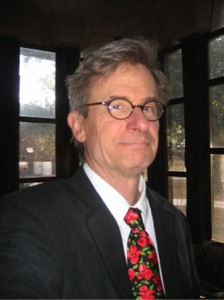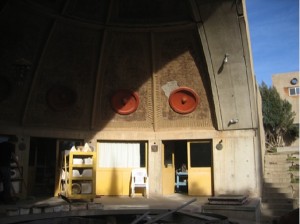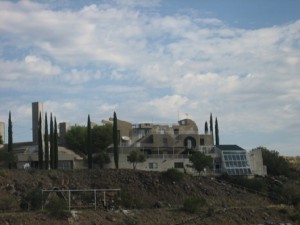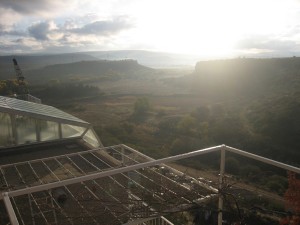In July 2012 the Cosanti Foundation, the organization that oversees Arcosanti, announced Paolo Soleri’s retirement as President, and the appointment of his successor, Jeff Stein, I was quite surprised. I’m not an Arcosanti insider by any means, but still, I just couldn’t imagine Soleri handing over the reins. But he did.
Despite having declared the end of production for A Life’s Work, my instinct was to hop on a plane to Arizona and interview Soleri and Stein. I didn’t, for various reasons. But I was recently put in contact with Stein and he graciously agreed to answer a few questions. But first, his bio.
Award-winning architect, writer, educator, Jeff Stein, AIA, is president of Cosanti Foundation. His first construction workshop at Arcosanti was in 1975. Since then he has spent time on the Cosanti staff; taught architecture in the Career Discovery program of the Harvard GSD; headed the department of architecture at Wentworth Institute in Boston; and was Dean of the Boston Architectural College for the past seven years. He has taught at architecture schools in the US and at the Technicum Winterthur, Zurich, and Ecole d’Architecture Languedoc-Rousillon, in Montpellier, France. Mr. Stein has written for Architecture Boston magazine and was for ten years architecture critic for the New England newspaper, Banker + Tradesman. He lectures widely about Arcosanti, energy and urban design, including at the recent Tel Aviv-Yafo Centennial Conference on Urban Sustainability, this past fall in Montreal at the 9th World EcoCities Congress and this spring at the Santa Fe Institute.
1.What’s your history with Arcosanti and Paolo Soleri?
Pretty much my entire adult life – for the past 35 years – is wrapped up with Arcosanti and Paolo Soleri. In 1974 I purchased the big black book, City in the Image of Man. MIT Press, its publisher, had a 50% sale, and when I received it in the mail, I opened it right up and spread it out – 4 feet long – across the conference table of the architecture firm where I was interning in the Midwest. That first big white page with the single sentence, “This book is about miniaturization,” started it all.
I came to Arcosanti the next year on a construction workshop and stayed for 7 years as part of the staff of Cosanti Foundation. I worked in the drafting room, built 2SUNS arcology models, made drawings to illustrate Paolo’s books, helped to put together several exhibitions, including one that travelled to 42 colleges and universities in the early 1980’s. I also helped produce the Arcosanti Festivals and conferences, including Teilhard and Metamorphosis in 1981.
At that event, the architect, writer and editor Peter Blake, spoke. Blake was an early proponent and publisher of Paolo’s work. After his talk he and I sat out on a rock by Arcosanti’s Foundry Apse and watched the Arizona sunset. “You’ll need to find your own voice in architecture, you know,” he said. “You should come to Boston, to the BAC/Boston Architectural College. We can propel you into the mainstream of architectural practice.” He was head of that venerable school at the time, and several people around Arcosanti had continued their careers in Boston through study at the BAC. I had graduated from a couple colleges by then, but had yet to finish architecture school.
So my wife, 2-year-old son, and I moved to Boston, and I became a student again for a time. I graduated, was licensed as an architect, worked for a couple firms, became a professor, headed Wentworth Institute’s architecture program, taught courses about arcology, started my own architectural practice, and for the past seven years I have served as dean of the BAC. I imagined that certain things had come full circle when this happened at BAC; but now that I’m back at Arcosanti, the circle is even more vivid.
2. As president of the Cosanti Foundation, what are your duties and goals?
The work is on several levels at once. Of course the main thing is to set a direction for Arcosanti’s continued development; and help to insure that we have resources and staff to pursue it. Parallel to that, we want to move ahead with the continued discussion of the idea of Arcology – architecture and ecology – at the highest levels nationally and internationally. The question out there, near the end of cheap fossil fuels and also, apparently, near the end of unprecedented personal wealth across a broad middle class in America and Europe, is, “How shall we live?” on the Earth. What pattern of development makes sense for humans and for millions of other species on the planet? The work that has gone on here at Arcosanti for more than a generation has important ideas to add to that discussion. There is also the business of the Soleri windbells and magnificent original art works that Paolo has created, and work that our craftspeople at Cosanti and Arcosanti continue to produce. And on a more personal level, I am here to support Paolo Soleri as he continues to develop ideas and make his own transitions.
I live at Arcosanti, and travel about one week each month, speaking publicly, pursuing opportunities on behalf Arcosanti. I am also helping to establish partnerships with institutions and governmental bodies to help foster Arcosanti’s growth as a resource for education and development globally.
I have been a member of Cosanti Foundation’s Board of Directors for the past several years, so I am current with the work that has been going on and with the issues that confront the Foundation as we move forward in a larger culture that is changing as we speak.
3. You’re filling some pretty big shoes. Was there a moment when you thought maybe you didn’t want to take this position?
When the Cosanti Foundation board suggested to me, last summer, that I was their pick, I was surprised(!), and I did indeed think twice about what it would mean. I telephoned my wife, Emilie, a painter and landscape designer in Boston. She said, “This will be important work. You need to do it. We’ll make our personal lives work out around it.” And that’s what we are doing.
Before taking the position, I spoke to Paolo Soleri at some length. When it became clear to me that he was comfortable with the idea, I agreed to it; and here I am, typing this from my apartment at Arcosanti, 10 months into the job. Carrying on this work is indeed important to me. I am doing it in a beautiful landscape, around terrific architecture, surrounded by a group of smart people, and visited on a daily basis by dozens of folks from around the globe who want to learn more about it. No more second thoughts required: we are moving ahead!
4. The times I’ve interviewed Soleri, he mentioned that he had hoped the pace of construction had been a little more rapid. At the same time, I feel like the construction of Arcosanti is very much about the journey and not the destination. Is there a way to move things along while keeping true to the idea that Arcosanti is a laboratory, a place that develops “organically.”
Arcosanti is more about process than product. It is important to the thousands of people who have helped build it so far because – as you rightly point out – “the journey is more important than the destination.” We are indeed a laboratory, experimenting not just with building and urban form, but overlaying those forms with an understanding of “frugare” –frugality. The goal is not to build something that can gather the highest rents possible; rather it is to create architecture that produces energy and allows for a complex sociability that is accessible to all.
But a work of architecture is usually the most expensive thing anyone ever purchases: a family home, a corporate headquarters, a public government building, these things cost money. So does Arcosanti. And here we are attempting to demonstrate a way of organizing a new relationship with each other and with the earth, by means of constructing architecture rather than by just publishing books about it (though we are doing that, too – 3 new ones just this year, 2012.)
To do this costs money. Arcosanti has so far been self-funding; that is we have bootstrapped ourselves by tuition from our construction workshops, from the sale of books, from tourism, and – improbably – from the sale of the windbells. To build more, we remain interested in the prospects of serious philanthropy. And we are also interested in investors who can take on certain aspects of the project. And we are looking at our own capabilities: we are able to be design consultants to others who might be interested in this work: governments, trans-national corporations, outside interests who can already see that the ideas generated by the project could go a long way to solving serious issues of human habitat and land and energy use.
5. I’ve been struggling to find a way to phrase this question and the only way I seem to be able to do it is via an analogy. Medieval cathedrals that took generations to complete often deviated from the original plans. One can see newer elements of style and construction that were incorporated as the project progressed over the decades. Contrast this with Gaudi’s cathedral, which hasn’t deviated much from his original concept. Would you say Arcosanti leans in one of these directions more than another? (If the facts of my analogy are debatable, feel free to say so.)
I think Arcosanti leans in the in the direction of the Medieval Cathedral. You could even say it leans in the direction of a city, an entity that has a master plan, but also has plenty of room for others to add their understanding and design ideas to it over time. At Arcosanti we are constantly learning, and building as a result of that experience. And yet, the entire project is overlaid with frugality, exploring the power of architecture to perform. Here’s an example:
When tourists visit Arcosanti (and 30,000 people come here each year) among the first things they ask is, “Where are all the solar panels?” In part they ask this because the idea of making electricity from the sun is a good one on the face of it; and also because people are all using so much technology: for lighting, communications, air conditioning, entertainment, etc. that to use more of it in the form of solar panels just seems somehow natural. And while we do have some solar electricity production here, we don’t just rely on that. Instead we have tried to make our architecture work harder than yours does. The forms of our buildings are not just for beauty, though they are beautiful, too. They shade themselves in summer, and with large openings facing south, the connected buildings at Arcosanti gather light and heat in winter, when we need it the most.
We use about 1/6 the electricity of other institutions we have compared ourselves to. The needs are human comfort, light to work by, warmth in winter, cooler shade in summer. You can get that – pretty inefficiently, I must say – by making electricity; or as we do at Arcosanti, you can get it by giving buildings a form that displays itself to the sun in a way that really works.
Paolo Soleri laid the foundation for this work, this search; and he gave us the initial building forms to undertake it. As we live with these forms and learn more about how they actually work in this place, in this climate, there is a natural evolution to the architecture. New people will be able to add new discoveries to Arcosanti using new materials and techniques. But the basic ideas: architecture and ecology harnessed together, miniaturization and complexity at the heart of the urban experience, will remain the same.
6. The question I have to ask: Do you think Arcosanti will be completed in your lifetime?
No, not in my lifetime. (And I plan to live for a long time, too!) Still, I don’t think Boston will be completed during my lifetime either, and it has been building for nearly 400 years. I do think Arcosanti, even in its current state – a fragment, really, of what it is meant to become – will begin to play a larger role in the International discussion of how we should live on the planet.
Arcosanti is here, it is not just an idea; it exists, you can visit it and stay overnight in its guestrooms, eat organic produce from its solar greenhouses, hike the high desert wilderness that it’s contained masterplan intends to preserve. And think about what its presence might mean for your own community, for your own life on Earth. Arcosanti’s presence poses some “What if?” questions:
What if we weren’t tied to cars as appliances? What if we could get to work, to school, to a grocery store without driving there, without spending that time and energy, without changing minerals into atmosphere by burning fossil fuels? Arcosanti means to demonstrate possibilities beyond the current culture; it means to allow humans to utilize space in a clearer more complex way. It means to show that, when we do reach the end of fossil fuels, when we do finally imagine that being separated as hermits in our single family houses is not the best way to live on the planet after all, that there is indeed a better, more sustainable, more fun alternative. Come visit us, I’ll show you.
Photographs courtesy of Jeff Stein.
Giant thanks to Jeff Stein for taking the time participate in this interview, special thanks to Sue Kirsch for making it happen.
[color-box color=”gray”]What’s A Life’s Work about? It’s a documentary about people engaged in projects they won’t see completed in their lifetimes. You can find out more on this page.
We recently ran a crowdfunding campaign and raised enough to pay an animator and license half of the archival footage the film requires. We need just a bit more to pay for licensing the other half of the archival footage, sound mixing, color correction, E&O insurance and a bunch of smaller things. When that’s done, the film is done! It’s really very VERY close!
So here’s how you can help get this film out to the world. It’s very simple: click the button…
Donate Now!
… and enter the amount you want to contribute (as little as $5, as much as $50,000) and the other specifics. That’s it. No login or registration required. Your contribution does not line my pocket; because the film is fiscally sponsored by the New York Foundation for the Arts, all money given this way is overseen by them and is guaranteed to go toward the completion of this film. Being fiscally sponsored also means that your contribution is tax-deductible. So why not do it? The amount doesn’t matter as much as the fact that you’re helping to bring a work of art into the world. And that, I think, is really exciting!
Questions? Email me at d a v i d ( aT } b l o o d o r a n g e f i l m s {d o t] c o m[/color-box]





Edward Hill
I’m sure I ‘found’ Soleri not too long after Mr. Stein did. The thing is, I was maybe 6 years old at the time and 60 Minutes ran a story on Arcosanti. He kept cropping up throughout the 70’s and early 80’s, mostly in those sort of ‘Hey, look at this FREAK with his mile-high science fiction cities!” kind of pieces. But the idea of arcology never really left me, and I sought it out when I was old enough to walk to the library by myself. Didn’t manage to get my own copy of that wonderful book until I was in my thirties, though…
David Licata
Thanks for the great comment, Edward!
Seeing the 60 Minutes episode at age six must have made quite an impression, and I could see where that could be a life-changer. I’ve written about that a lot, and it’s a part of the film: when we discover that life-long passion. Darden is so eloquent about it with Mahalia Jackson, who he first heard at age 8 or so. “I kept playing that record over and over. I kept coming back to that voice.”
Hope to see you around here again.
Best,
David